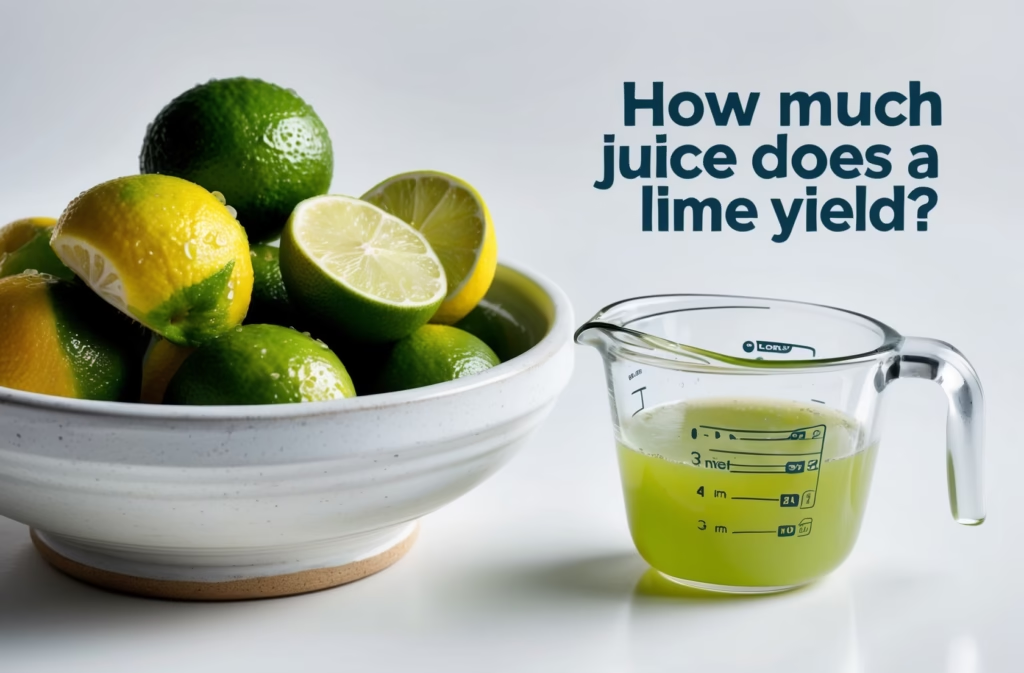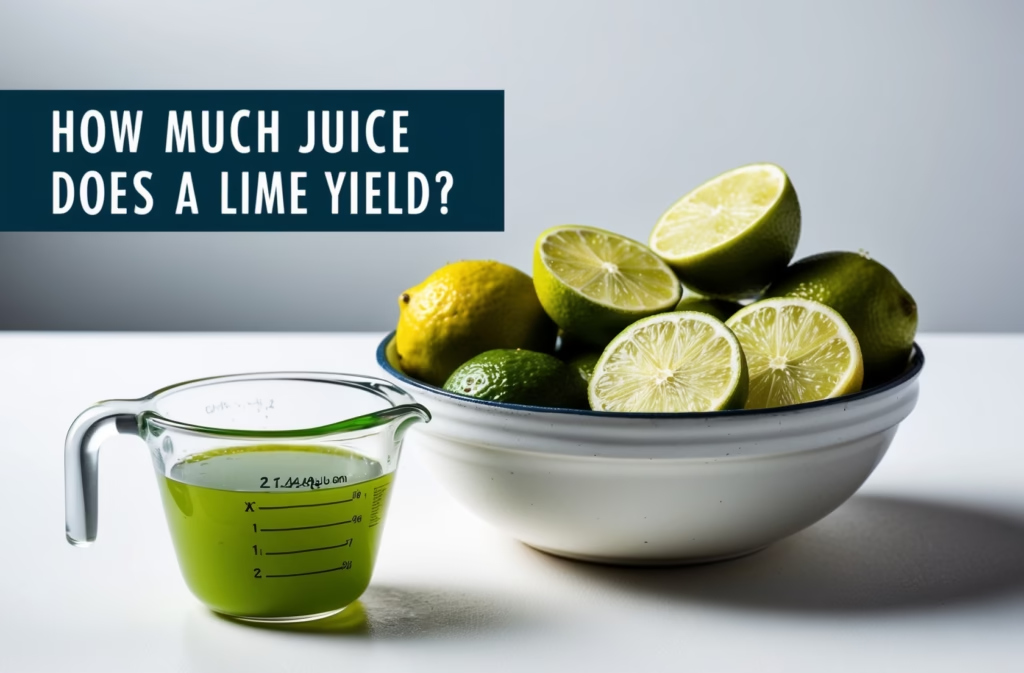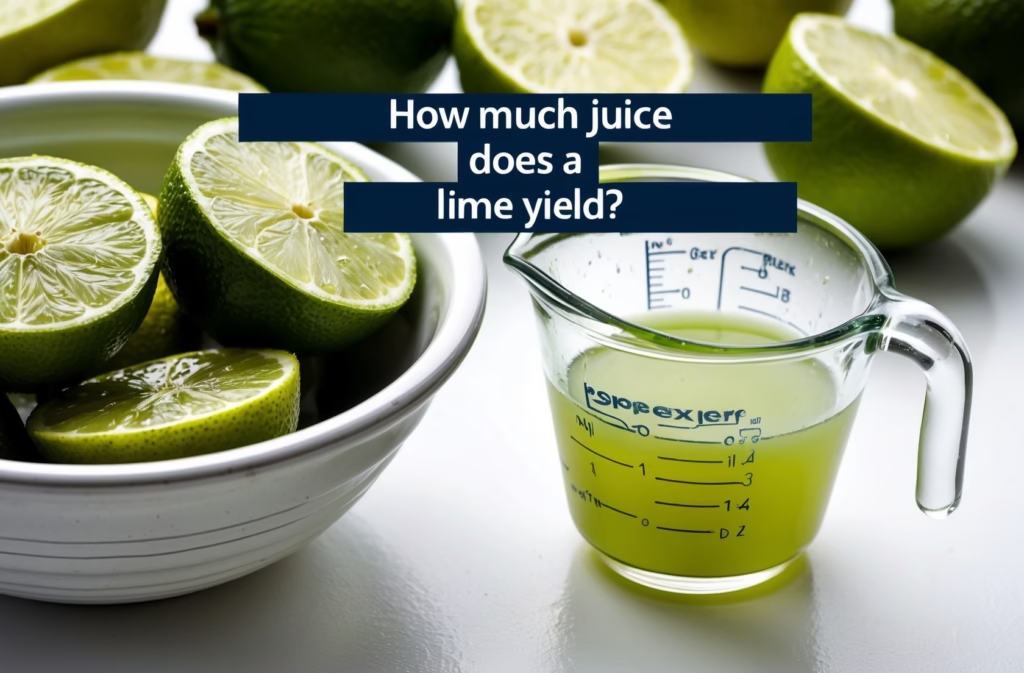Discover how much juice you can expect from a lime! Learn about lime juice yield & maximize your juice from limes. Get expert tips & tricks for juicing success. Find out now!
How Much Juice Does a Lime Yield? A Comprehensive Guide to Lime Juice Extraction
Knowing how much juice does a lime yield is crucial for various culinary applications. Whether you’re making a zesty margarita, a refreshing limeade, or adding a burst of citrus to your favorite dish, accurately predicting the lime juice yield ensures you have the right amount for your recipe. This comprehensive guide delves into the factors affecting lime juice yield, provides estimations, and offers tips for maximizing your lime juice extraction.
Understanding Lime Juice Yield: Factors at Play
The amount of juice from limes you get isn’t a fixed number. Several factors influence the lime juice yield, including:
Lime Variety
Different lime varieties have different juice contents. Key limes, for instance, are known for their higher acidity and generally yield more juice compared to Persian limes, which tend to be larger but less juicy. Understanding the type of lime you’re using is the first step to accurately estimating your lime juice yield.
Lime Size and Ripeness
Larger, ripe limes usually contain more juice than smaller, unripe ones. A plump, heavy lime will likely yield a greater amount of juice than a smaller, lighter lime of the same variety. Overripe limes, however, may have lost some of their juice content, resulting in a lower yield.
Extraction Method
The method you use to extract the juice significantly impacts your lime juice yield. Using a manual juicer, a citrus press, or even simply rolling the lime on the counter before juicing can affect how much juice is extracted. We will explore different extraction methods later in this article.
Storage Conditions
Proper storage is key to preserving the quality and juice content of your limes. Storing limes at room temperature can lead to quicker dehydration and reduced juice yield. Refrigerating limes can help extend their shelf life and maintain their juice content.
Estimating Lime Juice Yield: A Practical Guide
While there’s no single definitive answer to how much juice does a lime yield?, a reasonable estimation is crucial for planning your recipes. On average, a medium-sized lime (about 2 inches in diameter) can yield approximately 1-2 tablespoons of juice. However, this is just a guideline, and the actual yield can vary depending on the factors discussed above.
Maximizing Lime Juice Yield: Techniques and Tips
To ensure you extract the maximum amount of juice from your limes, consider these techniques:
Rolling the Lime
Before juicing, gently roll the lime back and forth on a clean countertop, applying firm pressure. This helps break down the cell walls inside the lime, making it easier to release the juice.
Using a Citrus Juicer
A good quality citrus juicer, whether manual or electric, is highly recommended for extracting the most juice from limes. These tools are specifically designed to efficiently break down the lime’s structure and extract its juice.
Microwave Technique
For a slightly unconventional method, you can microwave the lime for 15-20 seconds. This helps soften the lime and potentially improve juice extraction, though it’s best used as a complementary technique.
Recipes Utilizing Lime Juice
Lime juice adds a unique tangy flavor to many culinary creations. Below are a few examples and internal links to recipes you can try using the information you’ve just learned about maximizing lime juice yield:
For a refreshing summer drink, try this watermelon lime juice recipe. It’s a simple and delicious way to showcase the zesty flavor of lime.
If you prefer a more complex flavor profile, explore the delightful combination of tartness and sweetness in this cherry lime juice. This recipe uses the maximum amount of lime juice to balance the sweetness perfectly.
For a more tart and refreshing beverage, try this green apple mint juice. A squeeze of fresh lime elevates the taste to another level!
Looking for something a bit different? This mango orange juice uses lime as a complement to the sweeter fruits, balancing the flavors and enhancing the overall experience.
To round out our example drinks, let’s add this orange grapefruit juice option. The addition of lime juice helps to enhance the citrus flavors of this refreshing concoction.
Understanding Lime Juice Composition
Beyond simply knowing how much juice does a lime yield, understanding its composition is also important. Lime juice is rich in vitamin C, citric acid, and various antioxidants. The concentration of these components can affect its flavor and its use in different recipes.
For a deeper understanding of the chemical composition of lime juice, you can refer to the information available on the USDA FoodData Central database: USDA FoodData Central. This authoritative source provides detailed nutritional information for a wide range of foods, including limes.
Another excellent resource for understanding the role of citrus in cooking is the book The Food Lab by J. Kenji López-Alt: The Food Lab. The book explains the scientific basis for cooking techniques, including citrus juice usage.
Conclusion: Mastering Lime Juice Yield for Culinary Success
Mastering the art of lime juice extraction involves understanding the factors influencing lime juice yield, utilizing appropriate techniques, and employing effective tools. By following the tips and guidelines outlined in this article, you can accurately estimate and maximize your juice from limes for any culinary endeavor. Remember, a little extra care in selecting and juicing your limes can make a big difference in the overall quality and taste of your recipes. This comprehensive guide is designed to equip you with the knowledge and skills to become a lime juice expert in your kitchen!
Share Your Lime Juice Expertise!
We’d love to hear about your experiences with lime juice yield. Have you discovered any unique techniques for maximizing juice extraction? Share your tips, tricks, and favorite recipes using lime juice in the comments below! Let’s build a community of lime juice enthusiasts!

Frequently Asked Questions: Lime Juice Yield
- How much juice does a lime yield on average?
- A typical lime yields about 1-2 tablespoons (15-30ml) of juice. However, this can vary depending on the size and type of lime.
- What factors affect lime juice yield?
- The size of the lime, its ripeness, and the juicing method all influence the amount of Juice From Limes you obtain. Larger, riper limes generally produce more juice.
- How much juice can I get from a large lime?
- A large lime might yield up to 3 tablespoons (45ml) or more of juice. Again, it depends on the lime itself.
- How much juice can I get from a small lime?
- A small lime may only yield about 1 tablespoon (15ml) of juice, possibly less.
- Is there a way to maximize lime juice yield?
- Rolling the lime on a countertop before juicing can help break down the cell walls and increase the Lime Juice Yield.
- How can I measure the amount of lime juice I extract?
- Use a measuring spoon or cup to accurately measure the How Much Juice Does A Lime Yield. A kitchen scale can also be used if you need precise measurements.
- Why is my lime juice yield lower than expected?
- The limes may be underripe or of a variety that naturally produces less juice. Improper juicing techniques can also reduce the yield.
- Does the type of lime affect the amount of juice produced?
- Yes, different lime varieties have varying juice contents. Some types naturally produce more juice than others.
- Can I estimate the amount of lime juice needed for a recipe based on the number of limes?
- While an average can be used, it’s best to weigh or measure the juice directly to ensure accuracy in your recipe, especially for cooking or baking.
- Where can I find more information on How Much Juice Does A Lime Yield?
- Online resources and culinary websites often provide information on average yields for various fruits and vegetables, including limes.

How Much Juice Does a Lime Yield? A Chef’s Guide to Lime Juice Extraction
Many recipes call for lime juice, but knowing exactly how much juice you’ll get from a lime can be tricky. Understanding lime juice yield is crucial for accurate recipe measurements and preventing your dish from being too tart or too bland. This comprehensive guide explores how much juice does a lime yield, offering tips and tricks for maximizing your lime juice extraction. We’ll cover everything from selecting the right limes to efficient juicing techniques, ensuring you always have the perfect amount of lime juice yield for your culinary creations.
Factors Affecting Lime Juice Yield
The amount of juice from limes varies depending on several factors. The size and ripeness of the lime play a significant role. Larger, ripe limes generally yield more juice than smaller, unripe ones. The variety of lime also matters; some varieties are naturally juicier than others. Finally, the juicing method itself can impact the total yield.
For instance, using a manual juicer might extract less juice compared to an electric juicer. Even the temperature of the lime can slightly affect the juice yield; slightly warmer limes tend to release juice more readily. This isn’t a dramatic difference, but it’s something to keep in mind for larger-scale juice extraction.
How Much Juice Does a Lime Yield: An Average Estimate
On average, a single medium-sized lime yields approximately 1-2 tablespoons (15-30ml) of juice. However, this is just a general guideline. To get a more accurate measurement, you can weigh your limes before juicing and then weigh them again after to determine the exact amount of liquid extracted. This approach provides a consistent and reliable estimate of lime juice yield for future recipes.
Remember, this is just an average; smaller limes might yield less, while larger ones could yield closer to 3 tablespoons. It is always best to squeeze a few limes and measure the juice to get an accurate average for the specific batch you are using. You can then adjust the amount of limes according to your recipe’s needs.
Maximizing Lime Juice Yield: Techniques and Tips
To maximize the juice from limes, try these helpful techniques:
- Roll the lime: Before juicing, roll the lime firmly on a flat surface to help loosen the juice sacs inside.
- Microwave the lime: Microwaving the lime for 10-15 seconds can also increase juice extraction. Be careful not to overheat it.
- Use a good juicer: A quality juicer, whether manual or electric, ensures efficient juice extraction. A simple hand juicer is great for small batches, while an electric juicer is better for larger quantities.
- Don’t discard the pulp: While some people strain out the pulp, leaving it in adds texture and flavor to many recipes, and some nutrients. Learn more about the benefits of lime pulp.
Recipes Utilizing Lime Juice
Lime juice is a versatile ingredient, adding a zesty kick to countless dishes. Its bright, citrusy flavor complements both sweet and savory dishes. Here are some examples of refreshing drinks that showcase lime juice’s versatility:
- For a refreshing summer beverage, try our Cherry Lime Juice recipe.
- If you prefer something sweeter, our Watermelon Lime Juice recipe is a delightful option.
- Looking for something more complex? Our Green Apple Mint Juice combines the tartness of lime with the refreshing notes of mint and green apple.
- For those who like tropical fruit combinations, check out our Mango Orange Juice recipe, where lime adds a lovely contrasting zing.
- Another great choice for citrus lovers is our Orange Grapefruit Juice recipe that features a splash of lime for an extra twist.
Beyond beverages, lime juice is essential in many cuisines. From marinades for fish and poultry to vibrant salsas and dressings, its unique flavor profile enhances a wide range of dishes. The versatility of lime juice extends to baked goods, adding a subtle tang to cakes and pies.
Understanding Lime Juice Yield for Culinary Success
Precise measurement is essential in cooking. Knowing the lime juice yield helps ensure your dishes turn out perfectly. By considering the factors affecting juice extraction and employing effective juicing techniques, you can consistently achieve the desired amount of lime juice for your recipes. Remember to adjust your measurements based on the size of your limes and the recipe’s requirements.
For further information on the nutritional benefits of citrus fruits, we recommend checking out the USDA’s FoodData Central database. This database provides comprehensive nutritional information on a wide range of foods.
Accurate measurement of lime juice is also important from a nutritional standpoint. As we’ll discuss shortly, lime juice is a good source of Vitamin C, and knowing the accurate yield will help you track the amount of Vitamin C consumed.
Another great resource for understanding the nutritional value of foods is the Mayo Clinic website. This page provides insightful information on the importance of a balanced diet.
Nutritional Information (Per 1 tablespoon of Lime Juice)
Note: Nutritional values are approximate and can vary based on lime size and variety.
| Nutrient | Amount per Serving | % Daily Value (DV) |
|---|---|---|
| Calories | 2 | <1% |
| Protein | 0g | 0% |
| Total Fat | 0g | 0% |
| Saturated Fat | 0g | 0% |
| Unsaturated Fat | 0g | 0% |
| Trans Fat | 0g | 0% |
| Carbohydrate | 1g | <1% |
| Sugar | 1g | <1% |
| Fiber | 0g | 0% |
| Vitamin C | 3mg | 3% |
| Potassium | 1mg | <1% |
Summary of Nutritional Features
Lime juice is low in calories and fat, making it a healthy addition to many dishes and beverages. It is a source of Vitamin C, an essential nutrient for immune function and collagen production. While it provides minimal amounts of other vitamins and minerals, its refreshing flavor and versatility make it a valuable ingredient in a balanced diet.
Call to Action
Ready to experiment with lime juice yield and its culinary possibilities? Try out one of the refreshing recipes linked above, and let us know how much juice your limes yielded! Share your experiences and delicious creations on social media using #LimeJuiceYield. Leave a comment below sharing your tips and tricks for maximizing lime juice extraction. Let’s discuss how much juice you get from your limes and how you use them in your cooking!

How Much Juice Does a Lime Yield? A Practical Guide
The amount of juice you can extract from a lime varies considerably depending on its size and ripeness. A small lime might yield only about 1-2 tablespoons of juice, while a larger, juicier lime could produce up to 2-3 tablespoons. To maximize your yield, choose limes that feel heavy for their size and are slightly soft to the touch. Avoid limes that are hard and dry, as these will likely contain less juice. For recipes like a refreshing cherry lime juice, accurate juice measurement is key.
Several factors influence lime juice yield. The type of lime plays a role; some varieties are naturally juicier than others. Storage also matters; limes stored at room temperature will lose juice faster than those refrigerated. Proper juicing technique also significantly impacts the amount you extract. Rolling the lime on a counter before juicing helps break down the cell walls, releasing more juice. A citrus juicer is typically more efficient than hand-squeezing, especially if you need a large quantity for a recipe such as watermelon lime juice.
Health Considerations: While lime juice is a great source of Vitamin C and antioxidants, it’s important to consume it in moderation. Excessive consumption of acidic juices can erode tooth enamel, leading to dental problems. It is also advisable to dilute lime juice, especially if drinking it straight, to reduce the acidity. Consider incorporating lime juice into healthier drinks like green apple mint juice to balance its acidity with other ingredients. Additionally, individuals with certain stomach conditions might need to limit their intake of citrus juices.
Planning ahead is crucial. If you’re making a large batch of a recipe like mango orange juice that incorporates lime juice, it’s helpful to estimate the number of limes needed based on the expected yield. Remember to always taste-test as you go and adjust the amount of lime juice accordingly. Don’t forget that even the smallest amount can significantly impact the flavour.
For larger scale juicing projects, consider pre-juicing and storing the juice. Always refrigerate your freshly squeezed lime juice in an airtight container to preserve its freshness and prevent oxidation. This pre-juicing will save time when making recipes, such as orange grapefruit juice, that require multiple citrus fruits.
In conclusion, while the exact amount of juice a lime yields is unpredictable, understanding the factors that influence it and employing the right techniques can help you achieve optimal results. Always prioritize health considerations and enjoy your delicious, zesty creations responsibly.